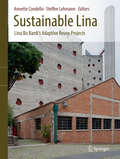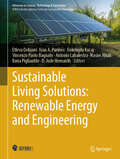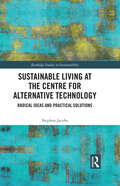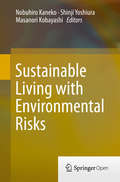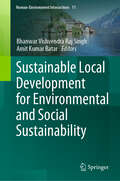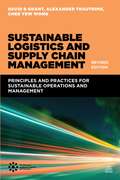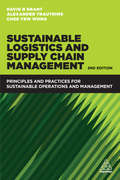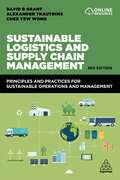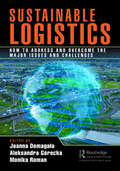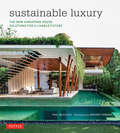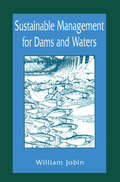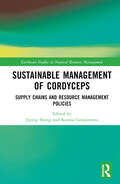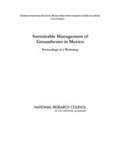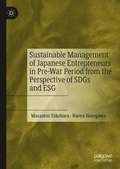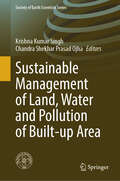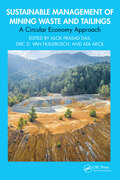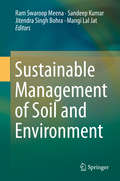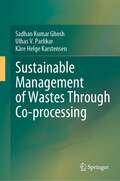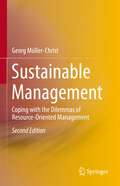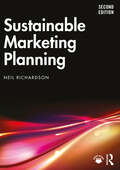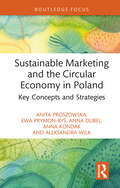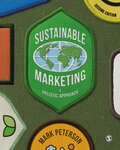- Table View
- List View
Sustainable Lina
by Annette Condello Steffen LehmannThis essential book unravels the link between regional cultures, adaptive reuse of existing buildings and sustainability. It concentrates on the social dimensions relating to Brazilian architect Lina Bo Bardi s late adaptive reuse projects and works from the 1960s to the early 1990s, interpreting her themes, technical sources and design strategies of the creation of luxury as sustainability. The edited book charts how Lina Bo Bardi invented her own version of sustainability, introduced this concept through her landscape and adaptive reuse designs and through ideas about cross-cultures in Brazil. The book offers a critical reflection, exploration and demonstration of the importance of adaptive reuse in the landscape and related themes for researchers and provides researchers and students new material on sustainability for further study. In the context of the plurality of revisions of Lina Bo Bardi s work, this book brings about a refreshed interpretation of her integrative approach to adaptive reuse of buildings and landscapes as a significant contribution to the sustainability debate. It offers new insights into the construction of discourses about sustainability from the perspective of one of the key architects in the period to operate in the interface between modernity and tradition. Dr Fabiano Lemes de Oliveira, Senior Lecturer, University of Portsmouth (UK)Adaptability is one of the most important words in sustainable architecture today. From this perspective, this book looks at the work of a master of Brazilian modernism with lessons to be learnt on how to qualify indoor and outdoor spaces in social, environmental and architectural terms. Adaptive strategies as those seen throughout the work of Bo Bardi are key instrument/tools/concept to sustainable buildings and cities. Professor Joana Carla Soares Goncalves, FAU, University of Sao Paulo (Brazil) The year 2015 marked the centenary of Lina Bo Bardi. This book is looking at Bardi's work through the perspective of adaptive reuse. Bringing together specialists on sustainability with specialists of Lina's work, the book generates an interesting new layer of discussion on the work of an architect that was never shy of controversy. Associate Professor Fernando Luiz Lara, University of Texas at Austin (USA)This collection of essays makes a very important and engaging contribution to suggest that to take Lina as an inspiration is to deal with her contradictions and to evaluate the stakes of what she struggled with in a 21st century world. What the authors gathered here and have laid out is a very timely invitation to discern Lessons from Lina in relationship to today s pressing issues of architecture and environment, sustainability, recycling, and developing an ethical design position in a world of diminishing resources and escalating challenges. -Prof Barry Bergdoll, Columbia University and MoMA, New York (USA)The book features a Foreword by Barry Bergdoll. "
Sustainable Living Solutions: Renewable Energy and Engineering (Advances in Science, Technology & Innovation)
by Ivan A. Parinov D. Jude Hemanth Hasim Altan Ilaria Pigliautile Etleva Dobjani Vincenzo Paolo Bagnato Enkelejda Kucaj Antonio LabalestraThis book includes topics that explore diverse and innovative aspects of architectural design, urban planning, infrastructure, and engineering. The "Values Trilogy Design Philosophy" emphasizes the harmonious integration of sustainability, cost-effectiveness, and artistic expression in architectural projects. "DIGIT-ACCESS" explores a digital gateway to enhance accessibility to heritage architectures. The influence of biomimicry and biophilia on sustainable urban planning is examined, along with the application of biomimetic approaches in smart city design and traditional architecture in Saudi Arabia's Asir region. An analytical study investigates zero-energy concepts in high-rise buildings, while another contrasts the thermal performance of various insulation systems in hot-desert climates. The role of interior design in fostering creativity and cultural enrichment in performance arts academies is highlighted, alongside an architectural appraisal of user perceptions toward Tamil Nadu Housing Board (TNHB) low-income housing schemes. In the realm of electrical, mechanical engineering, and fabrication, this book covers advanced topics such as reducing peak average power ratio in OFDM systems for cognitive radio, nonlinear buckling analyses of corrugated steel plate shear walls, and accelerated corrosion testing of carbon steel. The mechanical characteristics of sustainable rigid pavement using sintered fly ash aggregate are explored, as well as the impact of fiberglass reinforced concrete on sustainable design. Additional studies include the evaluation of water resistance in glass-modified concrete, the effects of laser treatment on waste poly(aramid) fiber for 3D printed composites, and the polymerization of copperas into polyferric sulfate for leachate treatment. Lastly, a thermogravimetric evaluation and kinetic study of pyrolysis in commercialized timber species in Peru provide insights into sustainable material behavior.
Sustainable Living at the Centre for Alternative Technology: Radical Ideas and Practical Solutions (Routledge Studies in Sustainability)
by Stephen JacobsThis book presents a detailed exploration into the Centre for Alternative Technology (CAT), an enterprise concerned with finding and communicating sustainable ways of living, established in Wales in 1973. Playing a central role in the global green network, this study examines CAT’s history and context for creation, its development over time, and its wider influence in the progression of green ideas at the local, national and international levels. Based on original archival and ethnographic research, this book provides the first in-depth analysis of CAT and uses the case study to explore wider issues of sustainability and environmental communication. It situates the Centre within current environmental and political discourse and emphasises the relevance and reach of CAT’s practical solutions and creative educational programme. These practical solutions to the destruction of the environment of human activity are increasingly vital in today’s context of climate change, loss of biodiversity and rising levels of pollution. It debates the spectrum of attitudes between environmentalism and ecologism evident at CAT and in broader conversations surrounding sustainability. Woven throughout the text, the author makes clear what we can learn from CAT’s almost 50 years of experiments and experiences, from his first-hand account of working at the site. This will be a fascinating and revealing read for academics, researchers, students and practitioners interested in all aspects of sustainability and environmental issues.
Sustainable Living with Environmental Risks
by Nobuhiro Kaneko, Shinji Yoshiura and Masanori KobayashiWe are not free from environmental risks that accompany the development of human societies. Modern economic development has accelerated environmental pollution, caused loss of natural habitats, and modified landscapes. These environmental changes have impacted natural systems: water and heat circulation, nutrient cycling, and biodiversity. These changes in natural systems degrade ecosystem services and subsequently increase environmental risks for humans. Environmental risks, therefore, are not only human health risks by pollution, climatic anomalies and natural disasters, but also degradation of ecosystem services on which most people are relying for their lives. We cannot entirely eliminate the risks, because it is not possible to attain zero impact on the environment, but we need to find a mechanism that minimizes environmental risks for human sustainably. This is the idea of the interdisciplinary framework of “environmental risk management” theory, which advocates harmony between economic development and environmental conservation. Based on this theory, the Sustainable Living with Environmental Risk (SLER) programme, adopted by the Japanese Ministry of Education (MEXT) as one of its strategic programmes, has been training graduate students at the Yokohama National University, Japan, from 2009 to 2013 to become future environmental leaders who will take the initiative in reducing the level of environmental risks and in protecting natural resources in the developing nations of Asia and Africa. This book provides students and teachers of this new academic field with a comprehensive coverage of case studies of environmental risks and their practical management technologies not only in Japan but also in developing nations in Asia and Africa.
Sustainable Local Development for Environmental and Social Sustainability (Human-Environment Interactions #11)
by Bhanwar Vishvendra Raj Singh Amit Kumar BatarThe world organizations, including national governments, have already recognized the importance of the Aichi Biodiversity Target, the Paris Agreement, Sustainable Development Goals (SDGs), Ecosystem-based Disaster Risk Reduction (Eco-DRR), Low Carbon Society. Therefore, there is an urgent need to act locally to tackle socio-economic, socio-ecological, socio-hydrological, and environmental conservation concerns in changing environments on a local to global scale and need to promote scientific solutions and common knowledge to achieve harmony between nature and humans under the threat of global climate change and the post-Covid-19 pandemic situation. For this purpose, the SLD approach is needed towards environmental and social sustainability. However, the SLD approach is challenging in terms of supply and demand of natural resources, resource depletion, socio-economic inequality, biodiversity loss, and climate change risk from local to the global scale, which vary based on different socio-economic, political, geographical, and cultural factors. Therefore, this book will highlight the environmental and social sustainability research by taking the local/regional case study. This book would also highlights the importance of policy interface at a local to global scale for environmental and social sustainability (ESS) in changing environments.
Sustainable Logistics and Supply Chain Management (Revised Edition)
by David B. Grant Chee Yew Wong Alexander TrautrimsAdopting sustainable practices is crucial for all businesses in the 21st century. Sustainable Logistics and Supply Chain Management is the essential guide to the principles and practices of sustainable logistics operations and the responsible management of the entire supply chain. Based on extensive research by experts in the field, this comprehensive book covers the whole scope of sustainable logistics. It provides carefully reviewed research-led applications and case studies that have been especially developed for this revised edition. Examining the subject in an integrated manner, this book examines all the key areas in sustainable logistics, including: sustainable product design and packaging; sustainable purchasing and procurement; cleaner production; environmental impact of freight transport; sustainable warehousing and storage; sustainable supply management; reverse logistics; and recycling; supply chain management strategy, and much more. A vital teaching resource for any course on sustainable logistics, this revised edition of Sustainable Logistics and Supply Chain Management includes valuable supporting online materials, including PPT presentations, chapter summaries, learning objectives, tips for teaching and in class activities.
Sustainable Logistics and Supply Chain Management: Principles and Practices for Sustainable Operations and Management
by David B. Grant Chee Yew Wong Alexander TrautrimsSustainable Logistics and Supply Chain Management is the essential guide to the principles and practices of sustainable logistics operations. Based on extensive research, this book covers the whole scope of sustainable logistics. The mini case studies, with particular attention for use in a teaching context, relate the theoretical concepts to practice and what is happening 'on the ground'. Sustainable Logistics and Supply Chain Management examines all the key areas in sustainable logistics and supply chain management, including: sustainable product design and packaging; sustainable purchasing and procurement; environmental impact of freight transport; sustainable warehousing and storage; and much more. Sustainable Logistics and Supply Chain Management is a highly accessible guide to sustainable supply chain management. It provides an excellent insight into the topic that will help managers, students, and scholars grasp the fundamentals of green supply and logistics management. A vital teaching resource for courses on sustainable logistics, this revised edition includes valuable supporting online materials.
Sustainable Logistics and Supply Chain Management: Principles and Practices for Sustainable Operations and Management
by David B. Grant Chee Yew Wong Alexander TrautrimsOur daily lives are permeated by the activities of logistics and supply chain, from food and clothing to doorstep deliveries. As these processes have the ability to significantly impact the natural environment, it has never been so important to develop and implement sustainable principles and practices.Sustainable Logistics and Supply Chain Management is an essential textbook for undergraduate and postgraduate students for understanding sustainability as it pertains to logistics operations. This book covers the direct environmental impacts of logistics and supply chain processes, including emissions and waste, as well as how wider changes such as globalization need to be given similar considerations. Presenting different pathways to guide readers, case studies and supported by extensive research, this book provides all the support needed to understand and implement a sustainable approach.Now in its third edition, Sustainable Logistics and Supply Chain Management is fully updated with the latest research and data including trends in logistics and supply chain management and new cases. Online resources include instructor manuals and complied lists of figures and tables.
Sustainable Logistics: How to Address and Overcome the Major Issues and Challenges
by Joanna Domagała Aleksandra Górecka Monika RomanLogistics refers to the processes that start with resources and their acquisition, storage, and transportation to their destination. The concept is crucial in business -- particularly for the manufacturing sector -- to understand, manage, and control how resources are handled and progress through the whole supply chain. Now, there is a strong trend to focus on sustainability and eco-friendly solutions in logistics. Processes based on both technology and management need innovations and detailed implementation steps to achieve a satisfactory level of sustainability. This book explores how and where innovations can be implemented to provide a wide approach to sustainability in logistics. It addresses the main challenges affecting modern and sustainable logistics and supply chains and is organized according to six main themes: supply chain management; information intelligent hubs (e.g. warehouse and cities); sustainable transportation; technology for logistics; reverse logistics; and city logistics. The key results presented are based on both extensive types of research and business cases. The overarching advanced logistics and supply chain concepts at the heart of this book contribute to a sustainable intelligent logistics and transport system by making it more efficient, reliable, environmentally friendly, and competitive. Essentially, this book presents the most current research related to sustainability in logistics activities and addresses the theoretical background of sustainability and its significance for logistics, the challenges in supply chains and transportation, and possible solutions for more sustainable logistics systems.
Sustainable Luxury
by Masano Kawana Paul McgillickSingapore is celebrated as one of the most livable cities in Asia, and Sustainable Luxury shows how the prosperous, forward-looking nation is pioneering innovative solutions for environmental, economic, social, and cultural issues faced the world over. Dr. Paul McGillick, the author of The Sustainable Asian House (Tuttle, 2013), presents twenty-seven recent residential projects created by Singapore's most talented architects to address the many complex and interconnected aspects of sustainability.Some of the homes featured here emphasize environmental needs, while others are concerned with preserving cultural traditions or supporting societal and interpersonal needs-such as extended family dwellings. Each residence, however, exhibits solutions developed from a holistic point of view. These homes typically embrace the tropical climate rather than fight it, and illustrate how smart manipulation of air flows, light, shade, water, and landscaping sustain higher levels of comfort without resorting to air-conditioning.In addition to profiling individual residences, Sustainable Luxury looks at the big picture, canvassing the most pressing issues-including changing demographics and lifestyles-and examining the available solutions. Anyone concerned with the future of our world will be fascinated by the houses presented here and the ways in which Singapore is leading the way in the development of residential architecture that is as luxurious as it is sustainable.
Sustainable Luxury
by Paul McgillickSingapore is celebrated as one of the most livable cities in Asia, and Sustainable Luxury shows how the prosperous, forward-looking nation is pioneering innovative solutions for environmental, economic, social, and cultural issues faced the world over. Dr. Paul McGillick, the author of The Sustainable Asian House (Tuttle, 2013), presents twenty-seven recent residential projects created by Singapore's most talented architects to address the many complex and interconnected aspects of sustainability. Some of the homes featured here emphasize environmental needs, while others are concerned with preserving cultural traditions or supporting societal and interpersonal needs-such as extended family dwellings. Each residence, however, exhibits solutions developed from a holistic point of view. These homes typically embrace the tropical climate rather than fight it, and illustrate how smart manipulation of air flows, light, shade, water, and landscaping sustain higher levels of comfort without resorting to air-conditioning. In addition to profiling individual residences, Sustainable Luxury looks at the big picture, canvassing the most pressing issues-including changing demographics and lifestyles-and examining the available solutions. Anyone concerned with the future of our world will be fascinated by the houses presented here and the ways in which Singapore is leading the way in the development of residential architecture that is as luxurious as it is sustainable.
Sustainable Management for Dams and Waters
by William R. JobinCyanobacteria and their toxins are an increasing global public health menace. Most recently, problems have been experienced in Australia, the United States and, due to drought and increasing water scarcity, pose a severe threat in the U.K. With an international range of contributors, all leading experts in their fields, Toxic Cyanobacteria in Water examines the increasing need to protect drinking water and water resources from the hazards of Cyanobacteria and their impact on health. Written and edited by a World Health Organization working group, Toxic Cyanobacteria in Water is an operational handbook in a practical, assessible style.Toxic Cyanobacteria in Water will be invaluable to environmental health officers, professionals in the fields of water supply, public health, fresh water ecology and education, national and international organizations, special interest groups, post-graduate students and utilities responsible for managing drinking water supplies.
Sustainable Management of Cordyceps: Supply Chains and Resource Management Policies (Earthscan Studies in Natural Resource Management)
by Ksenia Gerasimova Jiping ShengThis book examines the challenges of sustainably managing and conserving Cordyceps sinensis, a rare species of fungus largely grown in Tibet, currently on the brink of extinction.As one of the most expensive commodities in the world, particularly valued for its medicinal properties in China, the price of Cordyceps has risen by over 900% since the 1970s. This has made it a very lucrative resource for farmers, many of whom are struggling to produce sufficient food to sustain themselves. Naturally, this has led to overharvesting and, coupled with the impacts of climate change, the crop itself is now at risk. Rarely discussed in Western literature, this book provides a novel examination of Cordyceps, looking into the necessary changes needed to sustainably manage and conserve this important crop. Drawing on extensive field work conducted in Qinghai-Tibet, the book analyzes the supply chain, identifying key issues around production and considering the role and impact of relevant stakeholders. It discusses the necessary changes needed for a sustainable supply change, particularly to stop long-term overharvesting. The book then discusses the role of policy and the institutional management of this resource in China, as one of the main producers and consumers. It analyzes current policy instruments and argues for a more coherent policy which is better orientated towards conservation and sustainable management, rather than solely market regulation.This book will be of great interest to students and scholars of natural resource management, environmental conservation, environmental policy, and sustainable supply chain management.
Sustainable Management of Groundwater in Mexico: Proceedings of a Workshop
by National Research Council of the National AcademiesThis report contains a collection of papers presented at a workshop in Merida, Mexico --- Strengthening Science-Based Decision Making: Sustainable Management of Groundwater in Mexico. The cross-cutting themes of the workshop were the elements or principles of science-based decision making and the role of the scientific community in ensuring that science is an integral part of the decision making process. Papers included in this volume describe the groundwater resources of Mexico’s Yucatan Peninsula, approaches to managing groundwater in Mexico and governmental and scientific institutions concerned with water resources. Other papers discuss US approaches to managing scarce water resources. Participants in the workshop included representatives from leading scientific and academic institutions, federal state and local governments, non-governmental organizations and businesses.
Sustainable Management of Japanese Entrepreneurs in Pre-War Period from the Perspective of SDGs and ESG
by Masaatsu Takehara Naoya HasegawaThis book features 13 Japanese entrepreneurs who made a significant contribution to the development of society from 1868, when modernization in Japan began, to the 1950s, after World War II. They worked on solving social issues at the time through their businesses and succeeded in creating social value by solving social issues and economic value through the development of their businesses. The business philosophies they practiced have been passed on to their successors, and the companies they founded are now providing value to consumers around the world. Those 13 entrepreneurs anticipated the integration of solving social issues into corporate management, which modern companies are expected to realize under the umbrella of the Sustainable Development Goals (SDGs) adopted by United Nations in 2015. Their trajectories provide a wealth of practical knowledge necessary to survive in a changing society and provide many valuable lessons for modern companies and their managers.
Sustainable Management of Land, Water and Pollution of Built-up Area (Society of Earth Scientists Series)
by Chandra Shekhar Prasad Ojha Krishna Kumar SinghThis edited book is a comprehensive and forward-thinking exploration of the challenges and opportunities in building environmentally resilient and thriving cities. In a rapidly urbanizing world, the management of land, water, and pollution within built-up areas is a critical issue, and this book presents a wealth of knowledge to address it. It showcases a range of case studies and real-world applications that illustrate successful strategies and innovative solutions for urban sustainability. These practical examples offer valuable insights for urban planners, policymakers, and environmental practitioners.The book delves into cutting-edge research and visionary solutions. It goes beyond conventional approaches to explore emerging technologies and futuristic concepts, positioning itself at the forefront of urban sustainability. Readers will discover innovative ideas that can shape the future of urban development, making cities more livable, sustainable, and resilient.
Sustainable Management of Mining Waste and Tailings: A Circular Economy Approach
by Eric D. van Hullebusch Alok Prasad Das Ata AkçilIntegrating waste management, environmental sustainability, and economic development is a prime milestone in the circular economy. Critical metals recovery from mining tailings and secondary resources has significant potential, with widespread applications in high-tech industries that are critical to modern society and sustainable development. This book discusses technological advances for managing industrial and mining waste through circular economy approaches and successful critical metal recovery from secondary resources. It highlights how reprocessing of mine waste and tailings results in development of critical raw materials that significantly reduce the mining burden and ensure the lucrative use of waste materials.Features: Describes advances in remediation and valorization technologies for mining wastes Details biotechnological methods, cutting edge research, and applications Covers use of waste mining resources for economic growth and novel opportunities Discusses IR4.0 and machine learning methods Includes reports and case studies on mining waste in value-added products and recovery of strategically important critical minerals This book will be of value to researchers and advanced students working in the mining, chemical and environmental engineering, and renewable energy sectors.
Sustainable Management of Soil and Environment
by Sandeep Kumar Ram Swaroop Meena Jitendra Singh Bohra Mangi Lal JatFertilizers have been used extensively around the globe since the Green Revolution, due to the high subsidies. However, extensive fertilizer use exacerbates soil degradation and causes yield stagnation, and as a result threatens food security and soil sustainability, especially in developing countries. This means that sustainable soil and environmental management are vital to provide food and nutritional security for present and future generations. This has led to the International Union of Soil Science (IUSS) declaring 2015-2024 the International Decade of Soils. This book focuses on the impact of sustainable management of soil and environment on improving the functioning of soil-ecosystems and agronomic productivity, and also discusses food security, nutrient cycling, recent advances in INM technologies, eco-friendly cultivation, agricultural practices to reduce greenhouse gas (GHG) emissions, as well as conservation agriculture and its effects, and strategies for soil sustainability. Offering a comprehensive overview of management in the context of the sustainability of soil and the agroecosystems that it supports, it demonstrates the options available and provides insights into restoring soil health and matching soil nutrient supply with crop demand to ensure nutritional security in an eco-friendly environment.
Sustainable Management of Wastes Through Co-processing
by Sadhan Kumar Ghosh Ulhas V. Parlikar Kåre Helge KarstensenThis book is the first comprehensive book in the world on co-processing of wastes as Alternative Fuels and Raw materials (AFRs) in cement kilns. It discusses how AFR from wastes can play an important role in contributing toward reducing the use of fossil fuel and costs while conserving natural resources, lowering global CO2 emissions, and reducing the need for landfills. The use of AFR in resource and energy-intensive industries is called co-processing, which is discussed in detail highlighting both advantages and disadvantages. Co-processing in cement kilns is a technology that is practiced globally on a large scale for environmentally sound and ecologically sustaining management of wastes from agricultural, industrial, and municipal sources. Considerable amount of scientific and technological advancements has been put in place while developing and implementing this technology at the cement plant operational scales. This technology is in practice for about 40 years or so and has been recommended by Basel Convention for the sustainable management of hazardous wastes and by the Stockholm Convention for the sustainable management of POPs. This technology has now been included in the waste management rules notified by the Ministry of the Government of India and has been provided as a preferred option for the management of wastes over the conventional options of incineration and landfill. The book addresses how co-processing promotes mitigation of the climate change impacts and also conservation of the natural capital in addition to building a circular economy on a large scale.Even though this technology has received required attention and inclusion in the policy framework of many governments, its understanding and awareness with the stakeholders belonging to the academic and other relevant sections are vastly missing. The book will enhance the knowledge of co-processing technology among stakeholders involved in the implementation of the policy framework, design and engineering of the waste processing facilities to suit the co-processing operation, their operation and management, environmental consideration in implementing co-processing, operation and management of the cement plant, quality control, etc. In addition, the book will be useful for students and researchers working in this domain.
Sustainable Management: Coping with the Dilemmas of Resource-Oriented Management
by Georg Müller-ChristIn the second edition of this book, the concept of resource-based sustainability has once again been expanded to include further references to modern management theories. The author shows that overcoming the dilemmas that sustainability creates for companies and all organizations leads to more complex decisions that also require higher levels of awareness. The concept of sustainable leadership is closely related to the resource approach. Finally, readers will learn how to tell a compelling transformation narrative toward sustainability.
Sustainable Manufacturing and Remanufacturing Management: Process Planning, Optimization and Applications
by Weidong Li Sheng WangThis book reports on the latest research and applications in the fields of sustainable manufacturing and remanufacturing, as well as process planning and optimization technologies. It introduces innovative algorithms, methodologies, industrial case studies and applications.It focuses on two topics: sustainable manufacturing for machining technologies and remanufacturing of waste electronic equipment, and various methods are covered for each one, including macro process planning, dynamic scheduling, selective disassembly planning and cloud-based disassembly planning. The experimental analysis provided for every method explains the benefits, as well as how they are sustainable for various real-world applications. Further, a theoretical analysis and algorithm design is presented for each, accompanied by the contributors’ relevant research, including:• step-by-step guides; • application scenarios; • relevant literature surveys; • implementation details and case studies; and • critical reviews on the relevant technologies.This book is a valuable resource for researchers in sustainable manufacturing, remanufacturing and product lifecycle management communities, as well as practicing engineers and decision-makers in industry and all those interested in sustainable product development. It is also useful reading material for postgraduates and academics wanting to conduct relevant research, and a reference resource for manufacturing engineers developing innovative tools and methodologies.
Sustainable Marketing Planning
by Neil RichardsonThis book provides practical insights, tools and frameworks to help readers produce tactically and strategically appropriate marketing plans.Showing how to embed sustainability in these plans, students will be shown how to implement changes while being encouraged to reflect on why they are needed. The text reflects on contemporary themes that impact on sustainable marketing planning, including consumer behaviour, entrepreneurialism, internal marketing, services, international marketing, event management and digital marketing. The second edition has been fully updated with a greater focus on the issues surrounding sustainability, including the environmental challenges facing businesses, sustainable accreditation and integrating the UN SDGs. It provides background on the value discourses that underpin sustainability, incorporates new examples and case studies from broader regions around the world and introduces TBL-based loyalty. Full of tools and frameworks to improve comprehension, including chapter-by-chapter learning outcomes, summaries, exercises, applied activities and mini case studies, it bridges the gap between theory and practice effectively and accessibly.Presenting contemporary themes and challenges at the cutting edge of business research and practice, this book provides core reading for advanced undergraduate and postgraduate students of sustainable marketing, marketing planning and marketing strategy, as well as professionals seeking to improve the competitive advantage of their organisations.Online resources for the use of instructors include PowerPoint lecture slides and a multiple choice questions section.
Sustainable Marketing and the Circular Economy in Poland: Key Concepts and Strategies (Routledge Focus on Environment and Sustainability)
by Anita Proszowska Ewa Prymon-Ryś Anna Dubel Anna Kondak Aleksandra WilkSustainable Marketing and the Circular Economy in Poland outlines the specific challenges around formulating an organisation's marketing strategy in line with the circular economy (CE) framework.This book helps to solve the problem of ineffective pro-environmental programmes and marketing tools, which are currently used by enterprises to make their activities more sustainable. The authors identify key concepts and strategies of sustainable marketing to highlight the trends and development directions of marketing activities of modern enterprises. Focussing on Poland as a central case study, the book is illustrated with examples of organisations that are implementing sustainable marketing activities that are compatible with the CE model. It also presents the results of studies which examined the pro-environmental marketing efforts of small- and medium-sized enterprises, non-governmental organisations and other actors in Poland. To conclude, the authors put forward recommendations for CE network stakeholders regarding sustainable marketing management, focussing specifically on how to avoid accusations of greenwashing and other unethical organisational behaviour.This book will be of great interest to students and scholars of green marketing, sustainable business and the CE, as well as entrepreneurs and business professionals looking to formulate sustainable marketing strategies.
Sustainable Marketing: A Holistic Approach
by Mark PetersonBuilding on the idea that holistic marketing strategies allow firms to assess risk and realise opportunities, this book draws on new research and industry examples to help you recognize effective sustainability practices that benefit companies, stakeholders and society. With an issue-based approach that dissects the interplay between marketing and society, the author encourages readers to critically engage with the changing nature of markets; how companies can adapt to sustainability guidelines and environmental threats while still remaining profitable in today’s global market. Using a range of examples including Costco, Juul, Facebook, Patagonia and Bitcoin, Peterson highlights the importance of social issues facing businesses today such as poverty alleviation, the drive towards more ‘green’ living, corporate social responsibility within firms and political pressures such as emissions guidelines and reducing the global carbon footprint. The Mavericks Who Made It feature also highlights key entrepreneurs throughout history, their key successes and their impact on sustainable marketing.
Sustainable Marketing: A Holistic Approach
by Mark PetersonBuilding on the idea that holistic marketing strategies allow firms to assess risk and realise opportunities, this book draws on new research and industry examples to help you recognize effective sustainability practices that benefit companies, stakeholders and society. With an issue-based approach that dissects the interplay between marketing and society, the author encourages readers to critically engage with the changing nature of markets; how companies can adapt to sustainability guidelines and environmental threats while still remaining profitable in today’s global market. Using a range of examples including Costco, Juul, Facebook, Patagonia and Bitcoin, Peterson highlights the importance of social issues facing businesses today such as poverty alleviation, the drive towards more ‘green’ living, corporate social responsibility within firms and political pressures such as emissions guidelines and reducing the global carbon footprint. The Mavericks Who Made It feature also highlights key entrepreneurs throughout history, their key successes and their impact on sustainable marketing.
